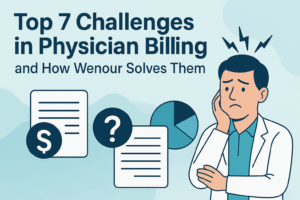In the demanding world of healthcare, physicians often find themselves juggling numerous responsibilities that can lead to burnout. Striving to provide optimal patient care while managing administrative tasks like EHR reporting, regulatory compliance, financial management, and marketing can feel overwhelming. However, by implementing strategies to streamline these time-consuming tasks, physicians can experience increased job satisfaction, foster staff commitment, and boost overall productivity. This blog aims to explore effective solutions that enable physicians to create a positive work environment, allowing them to focus on patient care, practice growth, and increased profitability.
- Recognizing the Impact of Administrative Burdens:
Physicians face an array of administrative burdens that significantly impact their professional lives. These include EHR reporting, meeting regulatory requirements, managing finances, and promoting their practice. Acknowledging the strain these tasks can cause is the first step towards finding viable solutions.
- Streamlining Administrative Processes:
a. Embracing Technology: Implementing user-friendly electronic health record (EHR) systems that streamline documentation, automate routine tasks, and enhance communication can significantly reduce administrative burdens. Leveraging technology enables physicians to spend more time on patient care rather than grappling with paperwork.
b. Outsourcing Non-Clinical Tasks: Delegating non-clinical tasks such as billing, coding, and revenue cycle management to experienced professionals or specialized service providers can alleviate the administrative burden on physicians. Outsourcing allows physicians to focus their expertise on patient care while ensuring efficient and accurate financial management.
c. Staff Training and Delegation: Providing comprehensive training to support staff and empowering them to take on administrative responsibilities can lighten the workload for physicians. Delegating tasks such as appointment scheduling, insurance verification, and patient follow-ups to competent team members allows physicians to prioritize clinical duties.
- Prioritizing Physician Well-being:
a. Establishing Work-Life Balance: Encouraging physicians to prioritize their well-being by fostering work-life balance is crucial in combating burnout. Promoting flexible scheduling, encouraging time off, and creating a supportive work environment that values self-care can lead to increased job satisfaction and reduced stress levels.
b. Promoting Peer Support and Mentorship: Facilitating peer support programs and mentorship opportunities within the practice or through professional organizations can provide physicians with a sense of camaraderie and guidance. Sharing experiences, challenges, and coping strategies with colleagues can help alleviate burnout and enhance professional growth.
- Investing in Practice Growth:
a. Marketing Strategies: Implementing targeted marketing initiatives, both online and offline, can attract new patients, increase visibility, and boost practice growth. Utilizing digital marketing tools, social media platforms, and patient referral programs can effectively promote the practice, allowing physicians to focus on patient care.
b. Continual Professional Development: Engaging in ongoing education, attending conferences, and staying updated on the latest advancements in the field not only enhances clinical skills but also fuels professional fulfillment. By investing in their own development, physicians can stay motivated and inspired in their practice.
Conclusion:
Physician burnout is a prevalent issue in the healthcare industry, but by implementing effective strategies, it is possible to create a positive work environment that prioritizes physician satisfaction and practice efficiency. Streamlining administrative processes, fostering work-life balance, promoting peer support, and investing in practice growth are essential components in combating burnout. By prioritizing patient care and reducing administrative burdens, physicians can find renewed enthusiasm for their profession, ultimately leading to a happier and more fulfilling healthcare practice.





